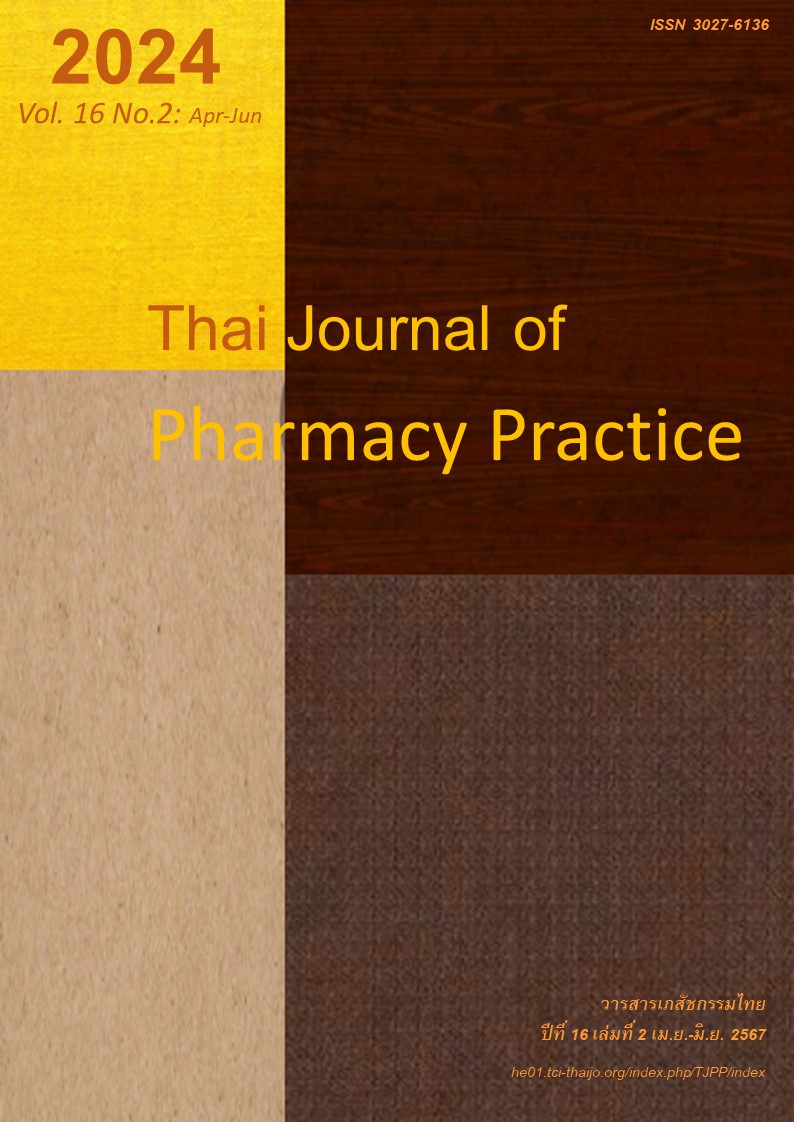ความชุกและปัจจัยที่มีผลต่อการจำหน่ายยาไม่เหมาะสม ของร้านชำในอำเภอจอมบึง จังหวัดราชบุรี
Main Article Content
บทคัดย่อ
วัตถุประสงค์: เพื่อสำรวจความชุกและหาปัจจัยที่เกี่ยวข้องกับการจำหน่ายยาที่ไม่เหมาะสมในร้านชำของอำเภอจอมบึง จังหวัดราชบุรี วิธีการ: การศึกษานี้เป็นการวิจัยภาคตัดขวางเชิงสำรวจ การศึกษาใช้แบบสัมภาษณ์และแบบสำรวจเก็บข้อมูลจากผู้ประกอบการร้านชำจำนวน 400 แห่งในเขตอำเภอจอมบึง ที่เลือกมาด้วยวิธีการแบบสุ่มอย่างง่ายระหว่างวันที่ 1 กรกฎาคม ถึง 2 กันยายน พ.ศ. 2565 ตัวแปรที่วัดได้แก่ ประเภทยาที่จำหน่าย ลักษณะต่าง ๆ ของผู้ประกอบการและร้านชำ และแรงจูงใจที่เกี่ยวกับการจำหน่ายยาที่ไม่เหมาะสม ข้อมูลถูกวิเคราะห์ด้วยสถิติเชิงพรรณนาและการถดถอยโลจิสติก ผลการวิจัย: จำนวนร้านชำที่สำรวจทั้งสิ้น 250 ร้าน พบร้านชำที่จำหน่ายยาจำนวน 179 ร้าน โดยจำหน่ายยาที่ไม่เหมาะสมหรือยาที่ไม่ใช่ยาสามัญประจำบ้าน จำนวน 136 ร้าน (ร้อยละ 75.98) ส่วนใหญ่จำหน่ายยาบรรจุเสร็จที่ไม่ใช่ยาอันตรายหรือยาควบคุมพิเศษ ยาอันตราย และผลิตภัณฑ์สมุนไพรที่ไม่ใช่ผลิตภัณฑ์สมุนไพรขายทั่วไปโดยไม่มีใบอนุญาตขาย ร้อยละ 67.65, 57.35 และ 63.24 ตามลำดับ พบการจำหน่ายยาอันตรายกลุ่มยาปฏิชีวนะ กลุ่มยา NSAIDs และยาชุดในร้านชำร้อยละ 12.50,10.29, และ 5.15 ตามลำดับ พบยาหมดอายุในร้านชำร้อยละ 12.29 แหล่งที่มาของยาที่ไม่เหมาะสมคือ ร้านขายยาแผนปัจจุบัน ร้อยละ 75.74 รองลงมาคือ ร้านขายส่งร้อยละ 13.97 แหล่งที่มาส่วนใหญ่อยู่ในอำเภอจอมบึง (ร้อยละ 79.41) ความต้องการของคนในชุมชนเป็นแรงจูงใจในการจำหน่ายยาที่ไม่เหมาะสมของร้านชำอย่างมีนัยสำคัญทางสถิติ (OR=4.25, 95%CI=1.23-14.71; P=0.022) ปัจจัยอื่นที่สัมพันธ์กับพฤติกรรมดังกล่าว ได้แก่ ระยะทางระหว่างร้านชำถึงร้านยา (OR=0.92, 95%CI=0.85-0.99; P=0.044) สรุป: ร้านชำในอำเภอจอมบึงมีความชุกสูงในการจำหน่ายยาที่ไม่เหมาะสม ซึ่งอาจนำไปสู่ความไม่ปลอดภัยจากการใช้ยาได้ การจำกัดหรือแก้ไขปัญหาต้องอาศัยความร่วมมือของผู้ประกอบการ ผู้บริโภค และภาครัฐทั้งการดำเนินของเชิงรับและเชิงรุก
Article Details

อนุญาตภายใต้เงื่อนไข Creative Commons Attribution-NonCommercial-NoDerivatives 4.0 International License.
ผลการวิจัยและความคิดเห็นที่ปรากฏในบทความถือเป็นความคิดเห็นและอยู่ในความรับผิดชอบของผู้นิพนธ์ มิใช่ความเห็นหรือความรับผิดชอบของกองบรรณาธิการ หรือคณะเภสัชศาสตร์ มหาวิทยาลัยสงขลานครินทร์ ทั้งนี้ไม่รวมความผิดพลาดอันเกิดจากการพิมพ์ บทความที่ได้รับการเผยแพร่โดยวารสารเภสัชกรรมไทยถือเป็นสิทธิ์ของวารสารฯ
เอกสารอ้างอิง
World Health Organization. Promoting rational use of medicines: core components [online]. 2002 [cite Nov 30, 2022]. Available from apps.who.int/iris/han dle/10665/67438.
Chowwanapoonpohn H, Suwannaprom P, Suttajit S, Pumtong S, Puripanyavanich N. Situations of developing to “RDU District” according to rational drug use national guideline. Nonthaburi: Food and Drug Administration; 2021.
Health Administration Division, Office of the Permanent Secretary. Rational drug use community: RDU community. Nonthaburi: Service Support System Development Group, Health Administration Division, Office of the Permanent Secretary, Ministry of Public Health; 2021.
Booddawong B, Kiatying-Angsulee N, Wanleepong K, Boonmanus L, Kadsomboon O, Dokbua J, et al. Source and distribution of unlawful medicines in 8 provinces of Thailand to inform the public policy change. Isan Journal of Pharmaceutical Sciences 2016; 11 (Supplement): 260-8.
Division of Social Statistics, National Statistical Office. The 2021 health and welfare survey. Bangkok: Thana Press; 2021.
Drug Act B.E. 2510. Royal Gazette No. 84, Part 101 special (Oct 20, 1967).
Yamane T. Statistics: an introductory analysis. 2nd ed. New York: Harper and Row; 1967.
Boonyoung U, Muenpa R. Prevalence of and factors affecting inappropriate sale of drugs in grocery stores within Phitsanulok province. Thai Journal of Pharmacy Practice 2019; 11: 105-18.
Jitprasithsiri S. Prevalence of illegal drug distribution among groceries in Sanamchaikhet district, Chachoengsao. Thai Journal of Pharmacy Practice 2019; 11: 387-96.
Boonyot S, Muenpa R. Situation on distribution and use of household drugs in community within a district in the Northeast. Thai Journal of Pharmacy Practice 2021; 13: 578-89.
Noisanit S, Ruengorn C. Development of a community model with no antibiotics, yachud and steroids containing drugs: a case study in Thung Luang subdistrict municipality, Khirimat district, Sukhothai. Thai Journal of Pharmacy Practice 2021; 13: 920-32.
Phetcharaburanin P, Saokaew S. Prevalence of unsafe medicines in groceries: a case study in the districts of Lom Kao, KhaoKho and Nam Nao in Phetchabun province. Thai Journal of Pharmacy Practice 2019; 11: 422-30.
Wiriyanutai P. Prevalence and characteristics of groceries that provided antibiotics in Ngao district, Lampang province. Thai Journal of Pharmacy Practice 2015; 7: 167-77.
Dokbua J, Kuntimong R, Puksahad H, Sunongbua N. The situation of drug distribution in the grocery store, Pathumratchawongsa district Amnatcharoen province. Journal of Consumer Protection (Onlline) 2021; 1: 37-44.
Nirattisai N, Kampangkeaw N. The challenges of Thailand’s public healthcare system during COVID-19 pandemic. Journal of MCU Social Development 2021; 6: 174-88.
Prasertsuk S, Wattananamkul V. Drug use in social and cultural dimension of urban community. Isan Journal of Pharmaceutical Sciences 2011; 7: 52-61.
Pattamasaravut P, Muenpa R. Development of model grocery stores from the civil state project on collective action for drugs safety in communities. Thai Journal of Pharmacy Practice 2020; 12: 601-11.
Seangsai K, Seangsai L, Prombut N. Development of intervention for reducing illegal distribution of drugs from the groceries in Mahachanachai district, Yasothon. Thai Journal of Pharmacy Practice 2022; 14: 62-9.


